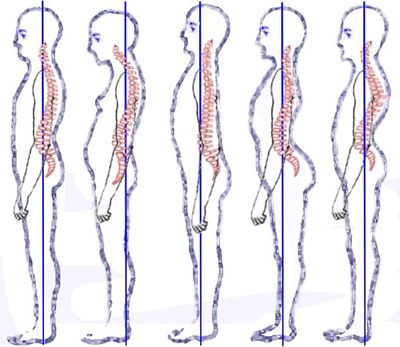What Postural Deviation Is Known as "Sway Back" ?
Definition [edit | edit source]

Sway-back posture shows an increase in posterior tilt of the pelvis and the trunk and thoracic kyphosis in comparison to neutral posture. See image second from left as distinct from the 2 images on right showing hyperlordosis lumber spine. This postural change is associated with increased activity of the rectus abdominis muscle and decreased activity of the abdominalinternal oblique muscle and decreased activity of the iliopsoas and gluteus maximus muscles in the hip joint. Sway-back posture reduces contraction of the skeletal muscles, thereby applying stress to the skeletal system, which is a factor not related to contraction, and leads to an increase in stress applied to the lumbar area.[1]
Four principal types of non-structural body posture misalignments in the sagittal plane: lordotic posture, kyphotic posture, flat-back posture, and sway-back posture. Each of them can disturb the physiological loading of the musculoskeletal system in a specific way, which may lead to a functional disorder.[2]
Mechanism of Injury / Pathological Process [edit | edit source]
The sway-back posture represents a faulty posture that differs from the good one by the following: 1. anterior pelvic shift, 2. thoracic kyphosis extended to the upper part of the lumbar spine (longer thoracic kyphosis is observed) 3. apparently shorter lumbar lordosis 4. normal or slightly decreased anterior pelvic tilt[2].
This could arise from faulty habitual postures and weakened muscles. eg Over-active/tight hamstrings, ligament laxity, incorrect strategy for good posture, bad habits such as sleeping on your stomach and poor posture in sitting. Swayback involves:
Lengthening of:
- Erector spinae in the upper thoracic and upper lumbar part,
- Scapulae stabilisers (serratus anterior, lower and middle part of trapezius and rhomboid muscles),
- Abdominal muscles (their lower part), and
- One-joint (iliacus, psoas), and two-joint hip flexors (rectus femoris, tensor fascia latae)
Shortening of muscles below that all show hyperactivity:
- Suboccipital, sternocleidomastoid, scaleni, muscles (all show hyperacivity)
- Chest muscles—pectoralis major and minor (all show hyperactivity)
- Erector spinae lumbar part (lower part),
- Upper fibers of abdominal muscles,
- Gluteus maximus
- Hamstrings (show hyperactivity)
Clinical Presentation [edit | edit source]
The position of body parts in the sway-back posture[2]
| Part of the body | Position |
|---|---|
| Head | Protracted (moved forward) |
| Cervical spine | Upper part: extended (hyperlordosis) Lower part: flexed (hypolordosis or kyphosis) |
| Thoracic spine | Upper part: increased flexion (hyperkyphosis) Lower part: normal (kyphosis) |
| Lumbar spine | Upper part: flexion (kyphosis or hypolordosis) Lower part: increased extension (hyperlordosis) |
| Pelvis | Shifted anteriorly, decreased anterior tilt |
| Hip joints | Extended due to decreased anterior tilt of pelvis |
| Knee joints | Neutral or hyperextended |
| Ankle joints | Neutral or plantar flexed |
Diagnostic Procedures [edit | edit source]
A good postural assessment
In the ideal posture, you should be able to draw a straight line between the greater trochanter and lateral malleolus.
In sway back note
- The centre of the hips are in front of the line of gravity.
- The pelvis is in a posterior pelvic tilt to neutral position.
Be sure to not misdiagnoseas other postural malpostion. See video below
[3]
Physiotherapy Management / Interventions [edit | edit source]
The sway back posture will places the body in sub-optimal positions which causes excessive stress through the structures[4]. Physiotherapy should be aimed at teaching postural concepts and postural control to the client and addressing the tight areas of soft tissue and strengthening weakened muscles. This includes the following:
- Hamstrings - need releasing and increasing flexibility.
- Strengthen hip flexors
- Strengthen gluteal group
- Strengthen external obliques/decrease rectus abdominis dominance
The compensatory postural changes importantly also need to be addressed, correcting Forward Head Posture and thoracic hyperkyphosis. This involves
Releasing/lengthening
- Anterior chest/shoulder, intercostals
- Sub-occipital/Upper cervical posterior
- Sternocleidomastoid/Scalene
- Upper abdominals
- Thoracic joints
- Fascia of the upper limb
- Latissimus dorsi
Strengthening
- Cx DNF/Retractors
- Scapula stability (rhomboid/lower trap/SA)
Re-train proper posture in functional positions (Neuro-muscular control). Functional training is all about using the right muscles at the right time, to sustain the correct posture, in daily activities. Simple activities like eg. correct standing posture, sit to stand and walking up stairs all need be addressed to ensure correct technique and muscle recruitment The brain, the nervous system, and muscles all work together to produce the desired result, so these neural pathways will need to be "reset". The client will find the new positions/techniques strange initially but with repetition will become the norm (we hope!). Remind the client there is no quick fix to this problem! Postural changes can be altered with practice and correct muscle recruitment.
References [edit | edit source]
- ↑ Fujitani R, Jiromaru T, Kida N, Nomura T. Effect of standing postural deviations on trunk and hip muscle activity. Journal of physical therapy science. 2017;29(7):1212-5. Available from: https://www.researchgate.net/profile/Kida_Noriyuki/publication/318436356_Effect_of_standing_postural_deviations_on_trunk_and_hip_muscle_activity/links/5971672b4585153016392695/Effect-of-standing-postural-deviations-on-trunk-and-hip-muscle-activity.pdf?origin=publication_detail (last accessed 10.12.2019)
- ↑ 2.0 2.1 2.2 Czaprowski D, Stoliński Ł, Tyrakowski M, Kozinoga M, Kotwicki T. Non-structural misalignments of body posture in the sagittal plane. Scoliosis and spinal disorders. 2018 Dec 1;13(1):6. Available from: https://www.ncbi.nlm.nih.gov/pmc/articles/PMC5836359/ (last accessed 10.12.2019)
- ↑ GeurillaZen Swayback vs. Anterior Pelvic Tilt (w/ Lordosis) Available from: https://www.youtube.com/watch?v=4Pa03FaaZKE (last accessed 10.12.2019)
- ↑ Posture Direct How to fix sway back Available from: http://posturedirect.com/how-to-fix-sway-back-posture/#5 (last accessed 11.12.2019)
What Postural Deviation Is Known as "Sway Back" ?
Source: https://www.physio-pedia.com/Sway_Back_Posture
Postar um comentário for "What Postural Deviation Is Known as "Sway Back" ?"